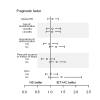Effectiveness of chest physiotherapy in infants hospitalized with acute bronchiolitis: a multicenter, randomized, controlled trial
- PMID: 20927359
- PMCID: PMC2946956
- DOI: 10.1371/journal.pmed.1000345
Effectiveness of chest physiotherapy in infants hospitalized with acute bronchiolitis: a multicenter, randomized, controlled trial
Abstract
Background: Acute bronchiolitis treatment in children and infants is largely supportive, but chest physiotherapy is routinely performed in some countries. In France, national guidelines recommend a specific type of physiotherapy combining the increased exhalation technique (IET) and assisted cough (AC). Our objective was to evaluate the efficacy of chest physiotherapy (IET + AC) in previously healthy infants hospitalized for a first episode of acute bronchiolitis.
Methods and findings: We conducted a multicenter, randomized, outcome assessor-blind and parent-blind trial in seven French pediatric departments. We recruited 496 infants hospitalized for first-episode acute bronchiolitis between October 2004 and January 2008. Patients were randomly allocated to receive from physiotherapists three times a day, either IET + AC (intervention group, n=246) or nasal suction (NS, control group, n=250). Only physiotherapists were aware of the allocation group of the infant. The primary outcome was time to recovery, defined as 8 hours without oxygen supplementation associated with minimal or no chest recession, and ingesting more than two-thirds of daily food requirements. Secondary outcomes were intensive care unit admissions, artificial ventilation, antibiotic treatment, description of side effects during procedures, and parental perception of comfort. Statistical analysis was performed on an intent-to-treat basis. Median time to recovery was 2.31 days, (95% confidence interval [CI] 1.97-2.73) for the control group and 2.02 days (95% CI 1.96-2.34) for the intervention group, indicating no significant effect of physiotherapy (hazard ratio [HR]=1.09, 95% CI 0.91-1.31, p=0.33). No treatment by age interaction was found (p=0.97). Frequency of vomiting and transient respiratory destabilization was higher in the IET + AC group during the procedure (relative risk [RR]=10.2, 95% CI 1.3-78.8, p=0.005 and RR=5.4, 95% CI 1.6-18.4, p=0.002, respectively). No difference between groups in bradycardia with or without desaturation (RR=1.0, 95% CI 0.2-5.0, p=1.00 and RR=3.6, 95% CI 0.7-16.9, p=0.10, respectively) was found during the procedure. Parents reported that the procedure was more arduous in the group treated with IET (mean difference=0.88, 95% CI 0.33-1.44, p=0.002), whereas there was no difference regarding the assessment of the child's comfort between both groups (mean difference=-0.07, 95% CI -0.53 to 0.38, p=0.40). No evidence of differences between groups in intensive care admission (RR=0.7, 95% CI 0.3-1.8, p=0.62), ventilatory support (RR=2.5, 95% CI 0.5-13.0, p=0.29), and antibiotic treatment (RR=1.0, 95% CI 0.7-1.3, p=1.00) was observed.
Conclusions: IET + AC had no significant effect on time to recovery in this group of hospitalized infants with bronchiolitis. Additional studies are required to explore the effect of chest physiotherapy on ambulatory populations and for infants without a history of atopy.
Trial registration: ClinicalTrials.gov NCT00125450.
Conflict of interest statement
All authors declare that (1) no financial support for the submitted work from anyone other than their employer; (2) no financial relationships with commercial entities that might have an interest in the submitted work in the previous 3 years; (3) no spouses, partners, or children with financial relationships that may be relevant to the submitted work; and (4) no non-financial interests that may be relevant to the submitted work.
Figures



References
-
- Glezen P, Denny FW. Epidemiology of acute lower respiratory disease in children. N Engl J Med. 1973;288:498–505. - PubMed
-
- Smyth RL, Openshaw PJM. Bronchiolitis. Lancet. 2006;368:312–322. - PubMed
-
- Koehoorn M, Karr CJ, Demers PA, Lencar C, Tamburic L, et al. Descriptive epidemiological features of bronchiolitis in a population-based cohort. Pediatrics. 2008;122:1196–1203. - PubMed
Publication types
MeSH terms
Associated data
LinkOut - more resources
Full Text Sources
Medical
Miscellaneous

